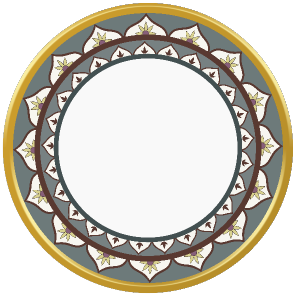

0


0

ART AND CULTURE
By Banani
14 December, 2015

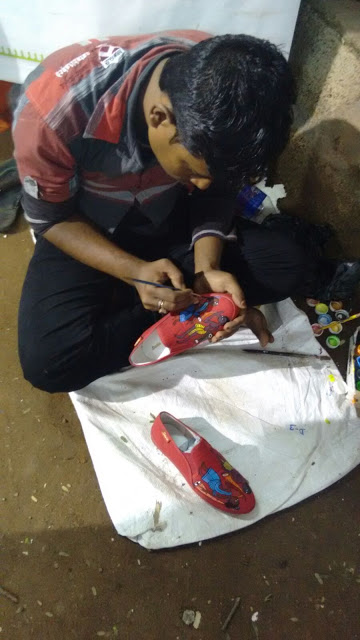 An Artist An Artist |
My love for arts and crafts had me walking into a five-day event “A hundred hands” (6th edition) held in Bangalore. The exhibition was initiated by the NGO ‘A hundred hands’ which was founded by Mala and Sonia Dhawan. And just like the name suggests, “A hundred hands” is formed by a hundred artistic hands. I was amazed to see people using sustainable ways of living. The centuries-old art is being kept alive due to its originality, uniqueness, and utilitarianism.
Pollinate Energy unit was the first of the stalls that I walked into. This social enterprise has come up to brighten the society using solar cells. The use of solar cells is an alternative to India’s urban poor population to make their lives better. This NGO is not only restricted to Bangalore but also extends to Hyderabad and Kolkata and is also linked to a charitable trust from Australia too. Working with this team as an intern will be a great challenge and one can gain exposure to Monitoring and Evaluation. A certificate will be generated at the end of the program. This is a way where one can help and change the lives of the poor.
Proper care should be taken if one has planted a plant or a seedling. Potting and caring a plant should be in a way such that one is taking care of one’s own baby. Monisha Lobo demonstrates this ideology in a perfect way. Monisha Lobo’s collection “Rare Earth” was an assemblage of spectacular plants. These plants have been grown in pots and hence known as “Pot gardening”. Due to her years of experiment and dedication, Monisha has the perfect knowledge of growing a succulent and bromeliad singly or together. “Each piece is easy to maintain as it is planted in sterilized soil-less potting mix”, Monisha said with enthusiasm. I must say that the plants were so decorative that adorn any part of the house.
An old man in his 70’s came all the way from Kutch to display his excellence in Charpai weaving. It takes only 2 days to complete a whole charpai. Right opposite to that, my eyes rolled over onto the colorful baskets. I learned that the craftsmen were from Uttar Pradesh and the multi-color baskets were made of grass. The baskets can be used as fruit or flower baskets which will enhance the beauty of your dining table.
Every state has its own style of carving things. Creativity has a story of its own. Likewise, the state Karnataka has its unique story of handlooms and embroidery. Usha J. Pawar started Kasuti embroidery back 25 years ago as her passion. Currently, Kasuti has become her obsession now drove her to take up summer classes. “Gavanti, Murgi, Negi and Mente stiches,” Usha showed me the different types of embroidery with pleasure. Through her work, she is trying to promote it more. The embroidery has been done for table mats, wall hangings, and even sarees. The embroidery was nature-driven since early days; as artisans used to draw whatever they used to see and got inspired. Hence, one can find temples, elephant, peacock and stars too in the creations.
As I enter the next shop I felt like stepping into the world of colors. Colors were used to draw various patterns like landscapes and nature; by using a heat source like iron or hot plate. The best part of this art is using beeswax which is generously coated with different colors. Arati Bedekar got inspired by this ancient art form of Greece, popularly known as Encaustic Art and can be transcribed onto canvas in different forms
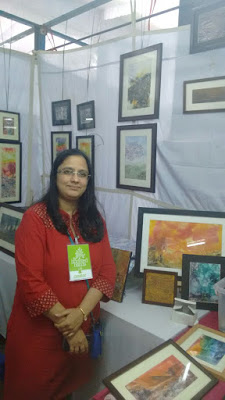
When people think about Indian Kitchen, it can’t be complete without our authentic spices. But wait, we use spices for preparing Pot Biryani, Chicken Kadhai, Paneer Butter Masala or Malabar Fish curry. However, Ms. J.S Jayanthi uses these spices to make different gifting stuff and home decors. She uses clove, cardamom seeds, cinnamon bark, star anise to make beautiful wall hangings and designs. “It’s a great gifting choice”, she said.
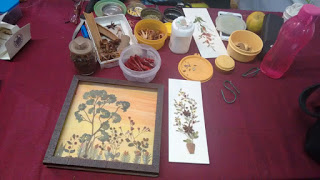
Mughals were famous for their varied interests on art and culture. They used to command to perform and praise different forms of music, dance forms and art. One of this is Wooden Block Carving which is in extinct status due to the digitalization. However, Mohammad is providing a great way to preserve this ancient art of India. He is one of them who started doing this since childhood. One can find animals, gods and goddesses, fruits, vegetables carved intricately on a wooden base. It’s an exceptional way to preserve one’s roots and even making a way out for employment.
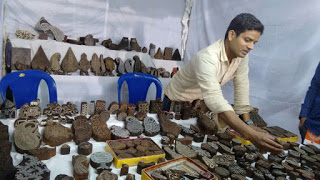
Our ancient India is wrapped with epics and Mythological stories, stories which our youths are rarely aware of. To educate them, Pattachitra can be of great help which demonstrates art in cotton clothes. This art-form India is privileged to own. Akshaya Kumar Bariki is one of them who has not only tried to keep this art alive but also been successful to scribble his name in golden words. He has been awarded in 2011 by UNESCO for his noble work.
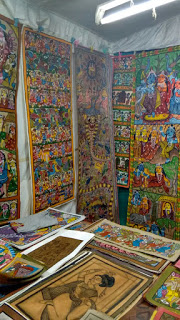
Our society is also blessed with physically challenged. The products which they produce are excellent and hence foundations like Diya Foundation and Foundation for Art and Culture for deaf showcase their talent to the world without any hesitation. They have products like candles and sketches which not only provide products to the market but also deliver a strong message of identifying one’s inner strength.
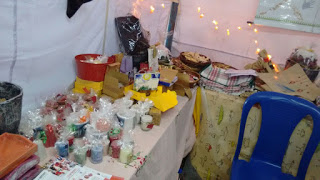
Kerala is famous for using natural colors. Mural Painting is a special art form of Kerala. Mural painting can be done in wooden bases to prepare neck pieces, wall hangings, earrings, and bracelets too. Murals can be found on temple walls.
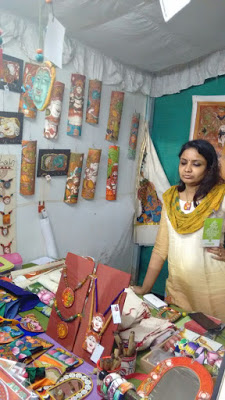
Tribes are our roots somehow or the other. Earlier days, people used to make their own houses, decorate it by themselves by using clay products, bamboo articles, etc. This shows that they were capable of producing their own products rather depending on factories. The worst part for them is poverty and hence cannot bring their products to the market. Hence, Tribal Health Initiative has jumped up to help this tribal community through “Porgai” program in Tamil Nadu. One can purchase a local tribal craft to empower them and, on the other hand, helps in promoting the dying art too.
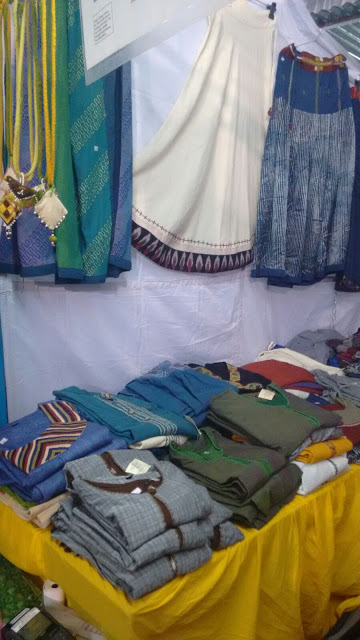
During my walk through the stalls, I passed by knitting store and even the Dying Art of Sanjhi Paper cutting. The silver store from Orissa sparkling with silver earrings and neck pieces tempted me to spend on those big “Jhumkas”.
Not but the least, I have the last counter “The Denim project”. If you want a trendy clutch, handbags, iPad covers, wallets I would suggest contacting this unit. These priceless products are manufactured by the Psychiatric patients of NIMHANS. I was mesmerized by seeing the amazing work. This project is growing day by day with an objective of providing employment to the needy. Please help them for this noble cause by donating your unused old jeans.
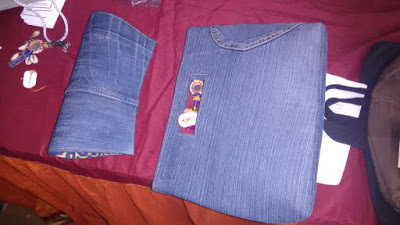
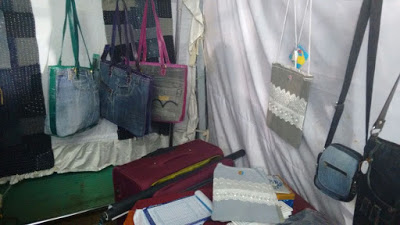
It’s conspicuous that there are many of us who are trying hard to preserve our tradition. People think India doesn’t have much scope in Art and Crafts as craftsmen don't get much exposure for their products. The products demand more of manual work which is also a big disadvantage and, in turn, increases the cost. Since, the demand is less for such antique products and hence production is low. These products are very rare and are not available in normal stores. For example, Tribal jewelry is in fashion however there are very few stores to display those. And in turn, the cost will be maximal. The products range from saree, Kolhapuri chappals, fabric from different parts of the country excites art and craft lovers. As per current scenario, this market is restricted to a particular niche of people. A majority of them are from upper urban class as they are comfortable in paying money. Most of the people visit to buy them, but very few understand their value. Once these priceless products hit the heart and mind of the common public, no one can stop flourishing this generic market. From now on, buy those cotton sarees from West Bengal, wall Hangings from Odisha and Kurtis from Lucknow. Let’s join hands to praise, promote and preserve the beauty of India.
Thank you for visiting the blog